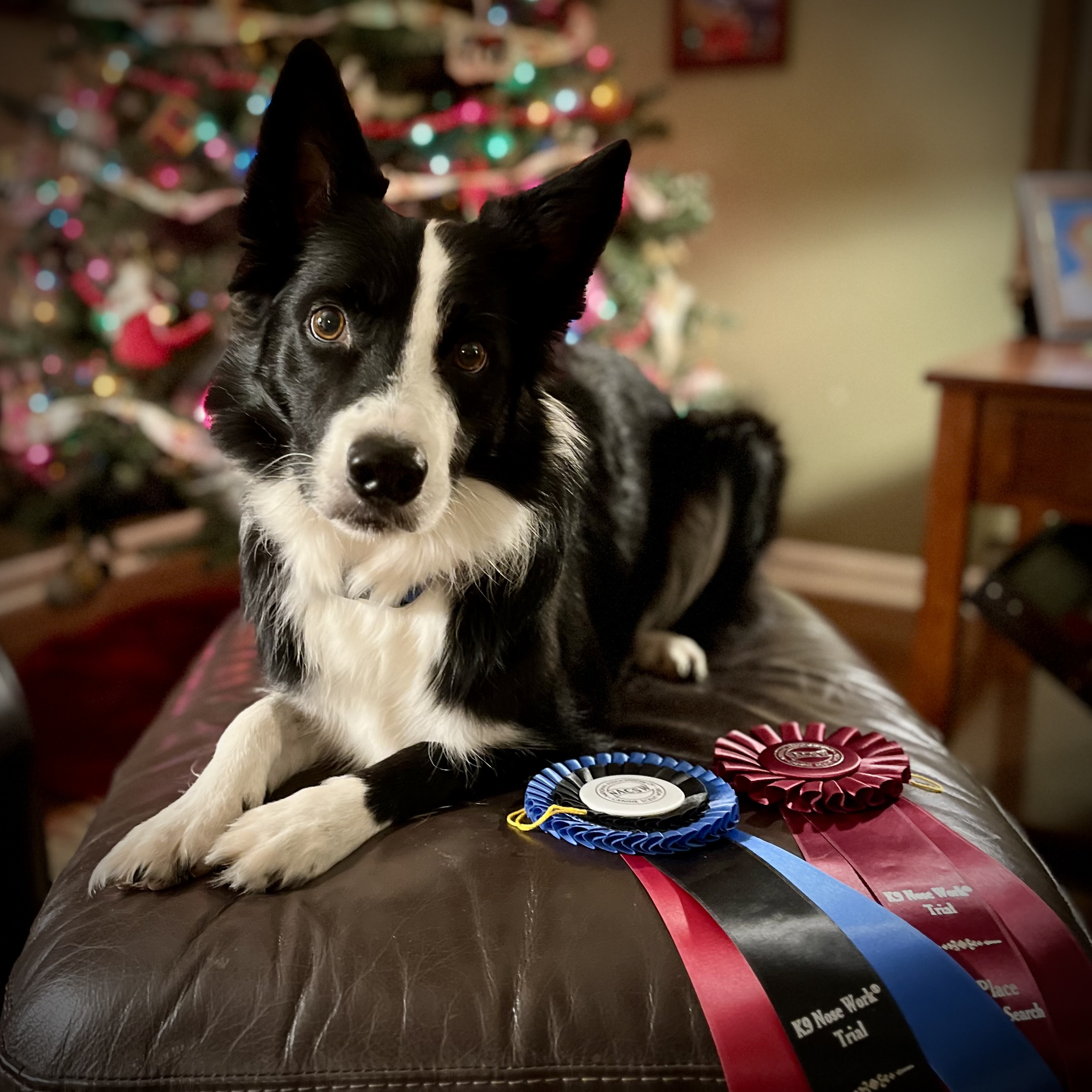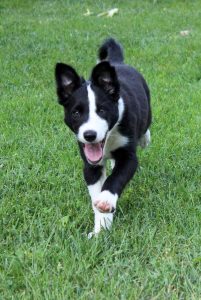
My Big Breakthrough in Nosework
How I eliminated barking from my dog’s searching to create a relaxed, confident working dog.
I’ve been involved in Nosework (NACSW style) for about 5 yrs. I started training my border collie Tai at age 10, shortly after his agility retirement. My only goal was to do something fun with him as he got older. I had no expectation or real desire to compete (we had competed a LOT in agility), but we did a little. Tai passed his ORT in one go; and earned his NW1 and three level 1 element titles. We only competed once in NW2 before I retired him for health reasons at 12-1/2 years old.
And Then Their Was Nick
About the time Tai retired from Nosework, I started Nick. He is a border collie, who came to Nosework at age 6 yrs after a serious injury that led to an early retirement in Agility. If you know Nick…you know he is a high drive, easily aroused bundle of energy! From the beginning of his Nosework training, Nick would allow that arousal to lead to barking – nearly always at the start of a search; and often when moving from one hide to another. He sometimes barked while searching, seemingly out of frustration, when not finding the hide quickly enough. Here is a good example of the barking issues in a search from March 2, 2024.
Nick was successful in this specific search, but was he searching as well as he could? Obviously not. I only included one example video because it was a very consistent behavior. I doubt I could find a video when he didn’t bark at least once, particularly as he left the start line.
Nick exhibited the barking early in his Nosework training. I didn’t like the barking and wanted to get rid of it. With my instructor’s help, I tried to lower his arousal with calmness and food at the start of the search. But honestly, it wasn’t working, so I just decided to live with it (not knowing what else to do). Despite the barking, I felt like he was growing his skill set and gaining confidence.
With the barking problem unsolved, Nick passed his ORT in Dec 2022 (2 attempts…due to arousal in first attempt) and his NW1 title in April 2023 (one attempt, overall pronounced). Then, we attempted FOUR NW2 titles between June 2023 and May 2024! Ugh, it was hard to fail that many times!! Each had only one little mistake along with many pronounced searches and placements. We had potential!
Was the barking and the mindset it created in Nick getting in our way?
The “Holly” Challenge
That brings us to August, 2024 when I met Holly Bushard…an accomplished competitor, instructor and trial official in Nosework. Holly came to Savvy Dog Sports to give a series of workshops. We had a working spot in one of the sessions and she spotted the “barking” problem immediately. In addition to all the other great information I gained at this workshop, Holly challenged me. She said something to the effect…”if this were my dog, I would get rid of the barking”. That got me thinking…
No Reward Markers
An important concept that Holly demonstrated in one of the workshops was the utility of “no reward markers” (NRMs) in Nosework training. A NRM communicates to the dog that the behavior he is exhibiting will not earn a reward. It’s a clear communication to the dog – “that’s not it… try something else.” Holly demonstrated their use in situations where a dog stopped searching and became obsessed with a distractor. The NRM marker was used to communicate to the dog – “that is not going to earn a reward, try again”.
I’m quite familiar with the use of NRMs…I use them in agility training, for example, when training discrete behaviors like weave entries, or verbal-only obstacle discriminations. I use them in herding when teaching off-balance flanks (don’t worry if you don’t understand that – it took me years!). But I have never used them in Nosework.
Since Nick had a history and understanding of NRMs from our previous training, I set about making a plan to extinguish his barking in Nosework using this technique! After all, if he is barking he’s not working and it was definitely worth a try.
The Goal
“Nick will do all his searches quietly and calmly, even when being rewarded with a tug-toy – his highest value reward.”
The Plan
- Use NRM’s to teach Nick if he barks, the consequence will be that we stop searching, we pause (timeout) and then start again. My NRM is “Nope”, or “No”.
- Start this training with very simple foundation-level searches. As he is successful increase the challenges.
- Increase his probability of success by instituting a controlled approach to the start-line. Start him from a bed and use “cookie to nose” to move him to the start-line to lessen the probability of his barking on the way to the start line. Pause at the start line before asking for the search. This had an important additional benefit of improving his start-line focus.
- Challenge Progression
- Hot tin thrown ahead into grass
- Colander “Search” – a more visible container
- Hot tin placed in the grass
- Three container searches (shell game type searches)
- Sock Searches – one hide
- Sock Searches – two hides
- Sock Searches – two hides with tugging as a reward
- White Box Container Searches – with and without distractors*
- Metal Box Container Searches with Multiple Distractors*
- Take it on the road – at class and other novel areas
*Nick is well schooled in searching around distractors so I didn’t think this would be a problem.
Execution of the Plan
Session 1:
Below is the full video of our first session on Aug 28, 2024 that included steps 1 to 4. It took some reps to get the mechanics right and I quickly learned that throwing a box into the grass was just increasing his arousal so I switched to a visible object (colander). The entire session is about 8 minutes long…As you can see his error rate was high at the beginning but once he had an understanding he settled and did very well. In this session, I learned the value of being quiet. It seemed to work best for him if I spoke very softly when cueing “Find it” or “Find another” and said nothing else during the search except marking the hide.
Session 2: We did the step 5 search on August 30, 2024 (Sock searches – one hide). I recorded every session so I could track his error rate. I wanted there to be a good balance of success and failure since that is how learning happens.
Results of Session 2 (Step 5):
- Rep 1 – NRM off the start line.
- Rep 2 – ok
- Rep 3 – NRM off the start line
- Rep 4 through 9 – ok. After Rep 9, I added “tugging” after the “Finish” cue.
- Rep 10 – NRM off the start line
- Rep 11 and 12 – ok with a little tugging after Finish cue
- Rep 13 – ok!
Sessions 3-5: Our third session on September 2, 2024 covered steps 6 & 7, introducing multiple hides and tugging. I’ve included that video below.
From there, I did two sessions on Sept 8th…using White Boxes (step 8) and another container search using three hot tins with cold tins and distractor tins (step 9). In each of these sessions, he had a very low error rate. He was really getting it.
Novel Area Search: Our next test was a search in a novel area. Fortunately, we had a class scheduled on September 12, 2024 at a local high school. I brought my bed with us to be able to set the context for “no barking”. The video below was our second search of the day. As you will see, he searched very nicely and was relaxed and successful with no barking.
Overall, Nick did fantastic in all our searches that day. His first three searches were perfect. In the 4th search, he needed one “no barking” reminder at the start line of the 4 hide search. In that same search, he also needed a reminder after finding 3 of the 4 hides, when I cued him to “find another”. The last hide was hard for him but after the reminder he worked in a relaxed manner with no barking. We let him keep going until finding the 4th hide. The total search lasted over 6 minutes.
Since September 12th, we’ve participated in classes and done our own training. I’ve had to give him very few reminders…literally one or two. Here is a compilation of a few searches from November – I was feeling very good about his progress.
The Ultimate Test
The ultimate test would be a trial. That happened at a NW2 trial on Dec 7th, 2024. I was ready to remind him of our new “no barking” rule even in this trial situation but it wasn’t necessary at all. Not only did Nick achieve his NW2 title, he earned a first place in containers and a pronounced designation in 4/5 searches. I was so pleased that there was NO BARKING and he was nicely focused at each start line! It was a pleasure to be able to reward each search with his favorite tugging game. 
Wrap-Up
I can say with confidence that I’ve eliminated Nick’s barking in Nosework. Even better, by eliminating the barking, Nick is more relaxed and confident in his searching, making the whole experience more enjoyable for both of us. We also now have a focused start line routine. All thanks to Holly’s challenge, the use of No Reward Markers — and a smart, biddable boy!






